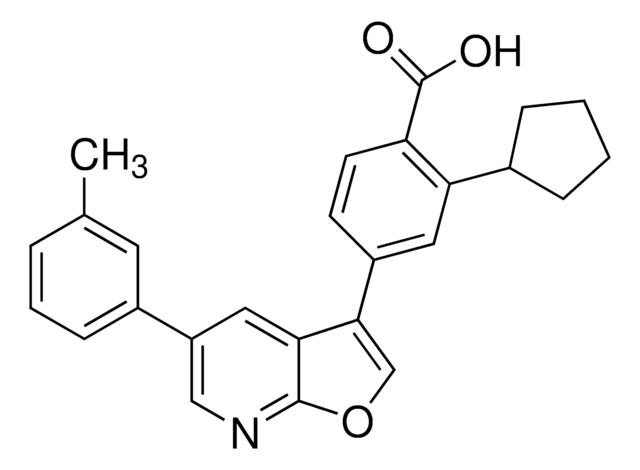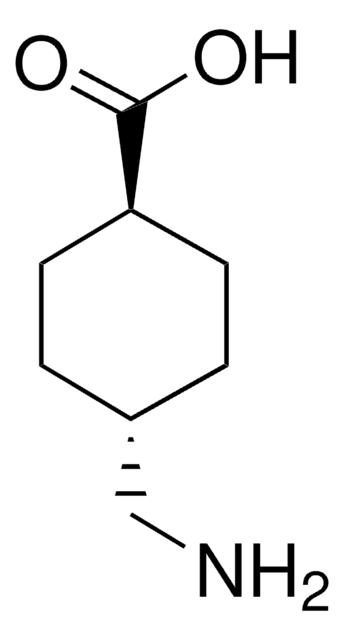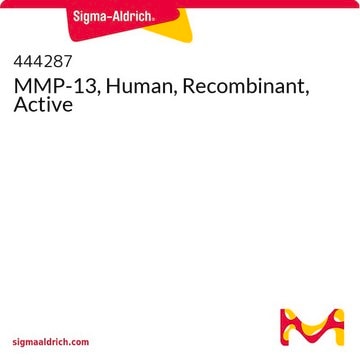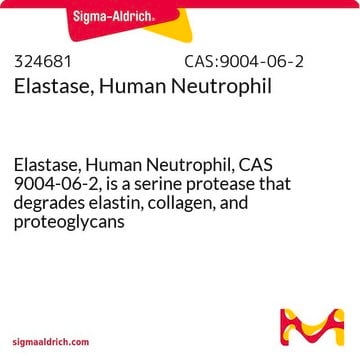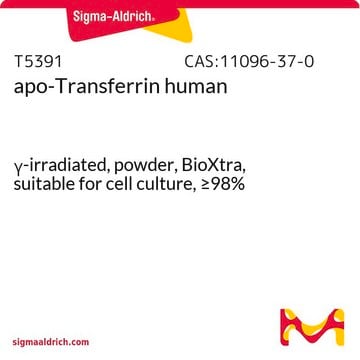CC1047
MMP-13, human, proform, his-tagged, E. coli recombinant
Sinônimo(s):
Procollagenase 3
Faça loginpara ver os preços organizacionais e de contrato
About This Item
Código UNSPSC:
12352204
eCl@ss:
32160405
NACRES:
NA.77
Produtos recomendados
fonte biológica
human
Nível de qualidade
Ensaio
>95% (total protein)
forma
liquid
atividade específica
250-300 mU/mg
fabricante/nome comercial
Chemicon®
concentração
0.2 μg/μL
nº de adesão NCBI
nº de adesão UniProt
Condições de expedição
dry ice
Informações sobre genes
human ... MMP13(4322)
Descrição geral
CC1047 is a recombinant 452 amino acid polypeptide corresponding to human Pro-MMP-13, with an additional C-terminal His-tag with the sequence GVTHHHHHH expressed in E. coli and purified from periplasm. The calculated Mr of the recombinant protein is 51.681 kDa. Upon activation with APMA activated MMP-13 is formed.
Matrix metalloproteinases (MMPs) are Zn2+- and Ca2+-dependent endopeptidases which function in the turnover of extracellular matrix components [Matrisian, 1992]. Main subfamilies of MMP are collagenases, gelatinases, stromelysins and membrane-type matrix metalloproteinases [Nagase, 1997]. Three homologous collagenases have been identified in human tissues: Interstitial collagenase, neutrophil collagenase and collagenase-3. These three enzymes cleave fibrillar collagens at a single site, generating fragments of approximately ¾ and ¼ the size of the original molecules.
ProMMP-13 [Procollagenase-3] consists of 452 amino acids with a calculated Mr of 52.520 [Freije et al., 1994]. Due to N-linked glycosylation, the actual Mr is about 60000 Da [Knauper et al., 1996]. Within the protein the following domains and sequence regions can be distinguished [Freije et al., 1994; Knauper et al., 1996]: An N-terminal propeptide, which confers latency to the proenzyme, a Ca2+ and Zn2+-ion binding catalytic domain, a hinge region, and a C-terminal hemopexin-like domain. Latent procollagenase-3 can be activated by proteases such as stromelysin [ Knauper et al., 1996], gelatinase A, MT1-MMP and plasmin [ Knauper et al., 1996] or incubation with APMA Knauper et al., 1996]. The Mr of active collagenase-3 which begins with the N-terminal sequence YNVFPRTL is 48,000 Da.
Collagenase-3 hydrolyzes type II collagen 5- to 6- times faster than type I and type III collagens. The enzyme also exhibits high activity towards gelatin and it degrades SERPINS as a1-antichymotrypsin and plasminogen activator inhibitor-2 [Knauper et al., 1996]. Collagenase-3 is inhibited in a 1:1 stoichiometric fashion by TIMP-1, TIMP-2 and TIMP-3.
Collagenase-3 is expressed during fetal bone development [Stahlebackdahl, 1997]. In adult human tissues collagenase-3 has been detected only in pathological conditions: in malignant tumors [Freije et al., 1994], in chronic ulcers [Valaamo et al., 1997], in arthritic cartilage [Mitchell et al., 1996] and synovium [Wernicke et al., 1996].
ProMMP-13 [Procollagenase-3] consists of 452 amino acids with a calculated Mr of 52.520 [Freije et al., 1994]. Due to N-linked glycosylation, the actual Mr is about 60000 Da [Knauper et al., 1996]. Within the protein the following domains and sequence regions can be distinguished [Freije et al., 1994; Knauper et al., 1996]: An N-terminal propeptide, which confers latency to the proenzyme, a Ca2+ and Zn2+-ion binding catalytic domain, a hinge region, and a C-terminal hemopexin-like domain. Latent procollagenase-3 can be activated by proteases such as stromelysin [ Knauper et al., 1996], gelatinase A, MT1-MMP and plasmin [ Knauper et al., 1996] or incubation with APMA Knauper et al., 1996]. The Mr of active collagenase-3 which begins with the N-terminal sequence YNVFPRTL is 48,000 Da.
Collagenase-3 hydrolyzes type II collagen 5- to 6- times faster than type I and type III collagens. The enzyme also exhibits high activity towards gelatin and it degrades SERPINS as a1-antichymotrypsin and plasminogen activator inhibitor-2 [Knauper et al., 1996]. Collagenase-3 is inhibited in a 1:1 stoichiometric fashion by TIMP-1, TIMP-2 and TIMP-3.
Collagenase-3 is expressed during fetal bone development [Stahlebackdahl, 1997]. In adult human tissues collagenase-3 has been detected only in pathological conditions: in malignant tumors [Freije et al., 1994], in chronic ulcers [Valaamo et al., 1997], in arthritic cartilage [Mitchell et al., 1996] and synovium [Wernicke et al., 1996].
Aplicação
ACTIVATION:
An aliquot of 19.5 μL procollagenase-3 is mixed with 0.5 μL APMA solution (40 mM p-aminophenyl mercuric acetate in DMSO) and the mixture is incubated for 30 minutes at 37°C. The mixture may be stored on ice until use for activity assays.
INHIBITORS:
MMP-13 is inhibited by TIMPs and by chelators of divalent cations such as EDTA or o-phenanthroline.
An aliquot of 19.5 μL procollagenase-3 is mixed with 0.5 μL APMA solution (40 mM p-aminophenyl mercuric acetate in DMSO) and the mixture is incubated for 30 minutes at 37°C. The mixture may be stored on ice until use for activity assays.
INHIBITORS:
MMP-13 is inhibited by TIMPs and by chelators of divalent cations such as EDTA or o-phenanthroline.
Definição da unidade
Specific Activity: where 1 U is the activity that hydrolyzes 1 μmol peptide (7-methoxycoumarin-4-yl)acetyl-Pro-Leu-Gly-Leu-Dpa-Ala-Arg) within 1 minute (Knight, 1992).
forma física
Provided as a liquid in 50 mM Tris-HCl, pH 7.5, 150 mM NaCl, 5 mM CaCl2, 0.05% Brij-35.
Armazenamento e estabilidade
Maintain frozen at -70°C in undiluted aliquots. The enzyme may be stored at -20°C for several weeks without significant loss of activity. Repeated freezing and thawing should be avoided.
Nota de análise
Pro-MMP-13 appears as a major band at about 60 kDa in SDS-PAGE
Informações legais
CHEMICON is a registered trademark of Merck KGaA, Darmstadt, Germany
Exoneração de responsabilidade
Unless otherwise stated in our catalog or other company documentation accompanying the product(s), our products are intended for research use only and are not to be used for any other purpose, which includes but is not limited to, unauthorized commercial uses, in vitro diagnostic uses, ex vivo or in vivo therapeutic uses or any type of consumption or application to humans or animals.
Código de classe de armazenamento
12 - Non Combustible Liquids
Classe de risco de água (WGK)
WGK 1
Ponto de fulgor (°F)
Not applicable
Ponto de fulgor (°C)
Not applicable
Certificados de análise (COA)
Busque Certificados de análise (COA) digitando o Número do Lote do produto. Os números de lote e remessa podem ser encontrados no rótulo de um produto após a palavra “Lot” ou “Batch”.
Já possui este produto?
Encontre a documentação dos produtos que você adquiriu recentemente na biblioteca de documentos.
Characterization of an exosite binding inhibitor of matrix metalloproteinase 13.
Lata T Gooljarsingh,Ami Lakdawala,Frank Coppo,Lusong Luo,Gregg B Fields,Peter J Tummino et al.
Protein Science null
Collagenase-3 (MMP-13) is expressed during human fetal ossification and re-expressed in postnatal bone remodeling and in rheumatoid arthritis.
St?hle-Backdahl, M, et al.
Laboratory Investigation; a Journal of Technical Methods and Pathology, 76, 717-728 (1997)
Cloning of collagenase 3 from the synovial membrane and its expression in rheumatoid arthritis and osteoarthritis.
Wernicke, D, et al.
The Journal of Rheumatology, 23, 590-595 (1996)
Activation mechanisms of matrix metalloproteinases.
Nagase, H
Biological Chemistry, 378, 151-160 (1997)
P G Mitchell et al.
The Journal of clinical investigation, 97(3), 761-768 (1996-02-01)
Proteolysis of triple-helical collagen is an important step in the progression toward irreversible tissue damage in osteoarthritis. Earlier work on the expression of enzymes in cartilage suggested that collagenase-1 (MMP-1) contributes to the process. Degenerate reverse transcription polymerase chain reaction
Nossa equipe de cientistas tem experiência em todas as áreas de pesquisa, incluindo Life Sciences, ciência de materiais, síntese química, cromatografia, química analítica e muitas outras.
Entre em contato com a assistência técnica